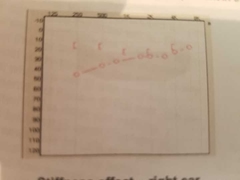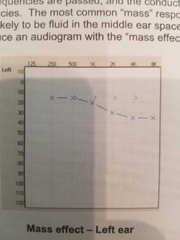![]()
![]()
![]()
Use LEFT and RIGHT arrow keys to navigate between flashcards;
Use UP and DOWN arrow keys to flip the card;
H to show hint;
A reads text to speech;
31 Cards in this Set
- Front
- Back
|
Transduction |
Process of changing one form of energy to another |
|
|
Pinna/Auricle |
Responsible for the gathering and localizing of sound. Natural acoustic resonator for sounds in the 2-5k frequency range. Very important for understanding speech |
|
|
Eam or external auditory Meatus/ eardrum |
Extends from the bowl of the concha to the TM or ty panic membrane |
|
|
Aperture |
The opening of the ear canal |
|
|
How long is the EAM or Ear canal |
1 1/2 inches long and approximately. .25 in diameter |
|
|
The outer 1/3 of the EAM is... |
Cartilaginous with thick skin over cartalidge. Contains hair cells, sebaceous oil glands and cerumen glands. |
|
|
Osseous |
Inner 2/3 of the ear canal. It is located past the second bend and comprised of thin skin over bone. Also more prone to irritation. |
|
|
Aperture |
Where the first bend is located. At the opening to the ear canal |
|
|
Ithmus |
A slight narrowing of the ear canal (also location of second bend) where cartaligenous and osseus portions meet. |
|
|
Resonant frequency |
The frequency at which an object, or tube of air, naturally vibrates. The resonant frequency of the open ear canal is 2500-3500Hz which gives an extra boost of about 10 dB in that frequency range. That, combined with the high frequency boost by the Auricle, is 15-20 dB |
|
|
Vagus Nerve |
Branch of the 10th cranial nerve. Passes through the bottom of the EAM. When it is stimulated (like when placing the cotton dam in the ear canal with the light) can cause a cough reflex. This is Arnolds reflex |
|
|
TM or tympanic membrane |
This is the eardrum and also the dividing line between the outer and inner ears. |
|
|
Pars Tensa |
Located at the bottom 80% of the ear canal, which is also the greater part of the ear canal |
|
|
Pars Flaccida |
The triangular shape at the top of the eardrum. |
|
|
Pars Flaccida |
The small triangular shape at the top edge of the eardrum |
|
|
Umbo |
The central part of the TM |
|
|
The cone of light |
The landmark of a healthy eardrum seen as a reflected like while doing an otoscopy of the ears. The TM is concave. |
|
|
Angular ligament |
Connects the TM to the bony wall of the ear canal by a tough fibrous ring. |
|
|
Occicles |
The smallest bones of the human body attached to the TM in the middle ear. |
|
|
The occicles consists of... |
The hammer, anvil, stirrup OR in medical terms the malleus, incus and the stapes |
|
|
What is the main function of the occicles |
They act as an impedence matching device, which is "resistance to flow" |
|
|
In the ear sound travels from... |
Low impedance air pressure waves of sound to the high impedence hydraulic fluid system of the cochlea |
|
|
Stapes |
In the Oval window. Vibrates in piston like manner, sending the vibration of sound into the fluid of the cochlea. |
|
|
When the Ossicular chain does not function properly it will cause what type of hearing loss? |
40dB HL conductive hearing loss |
|
|
Tensor tympani muscle |
Attaches to the malleus. When it contracts it pulls forward in opposition to the stapedious muscle which tightens the tympanic membrane |
|
|
Purpose of the stapedious muscle and tympani muscle |
Creates the acoustic reflex which is thought to add some protection for loud sounds but takes 60-120 milliseconds to kick in. In other words a sudden loud sound like a gunshot would still damage the ear because this mechanism wouldn't have enough time to protect the eardrum or TM |
|
|
The eustachian tube |
The middle ears air pressure equalizing system. Because the middle ear is encased in bone it can only communicate with the outside atmosphere except through the eustachian tube. |
|
|
The eustachian on tube in adults |
35 - 40 mm long. Travels through 10 mm of bone and then 25-30mm of cartilage. Tilted 30-40 degrees down from the horizontal |
|
|
The eustachian tube in children |
Closer to the horizontal plane. Wider and shorter. As a result, children are more likely to get ear infections. Commonly known as eustachian tube dysfunction |
|
|
Stiffness effect |

Appears in audiogram where high frequencies are passed and where the conductive component. |
|
|
Mass effect |

Opposite of stiffness effect. Low frequencies are passed and conductive component is in the high frequencies. Usually caused by fluid in the middle ear space |

